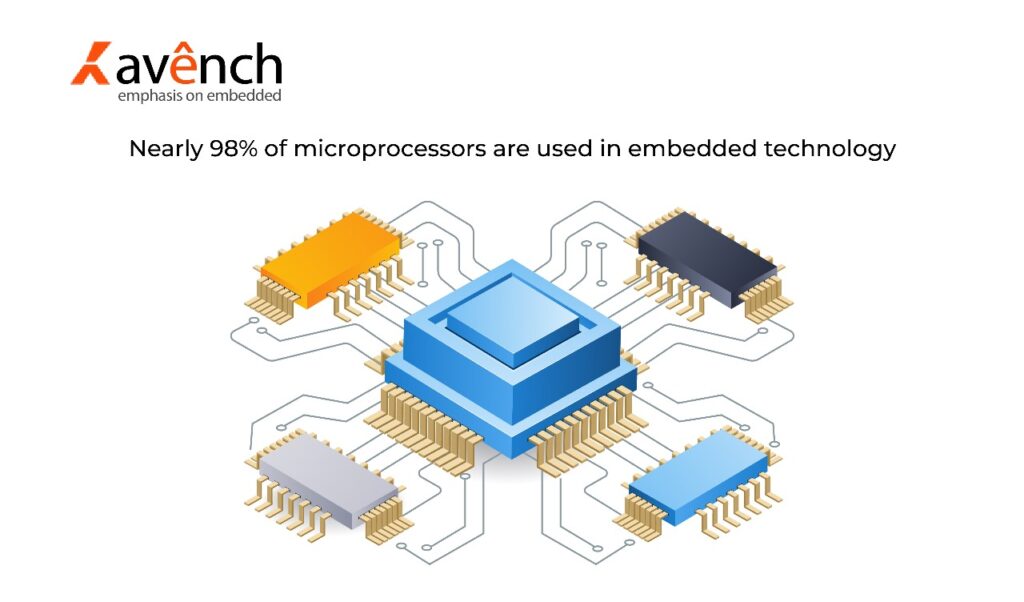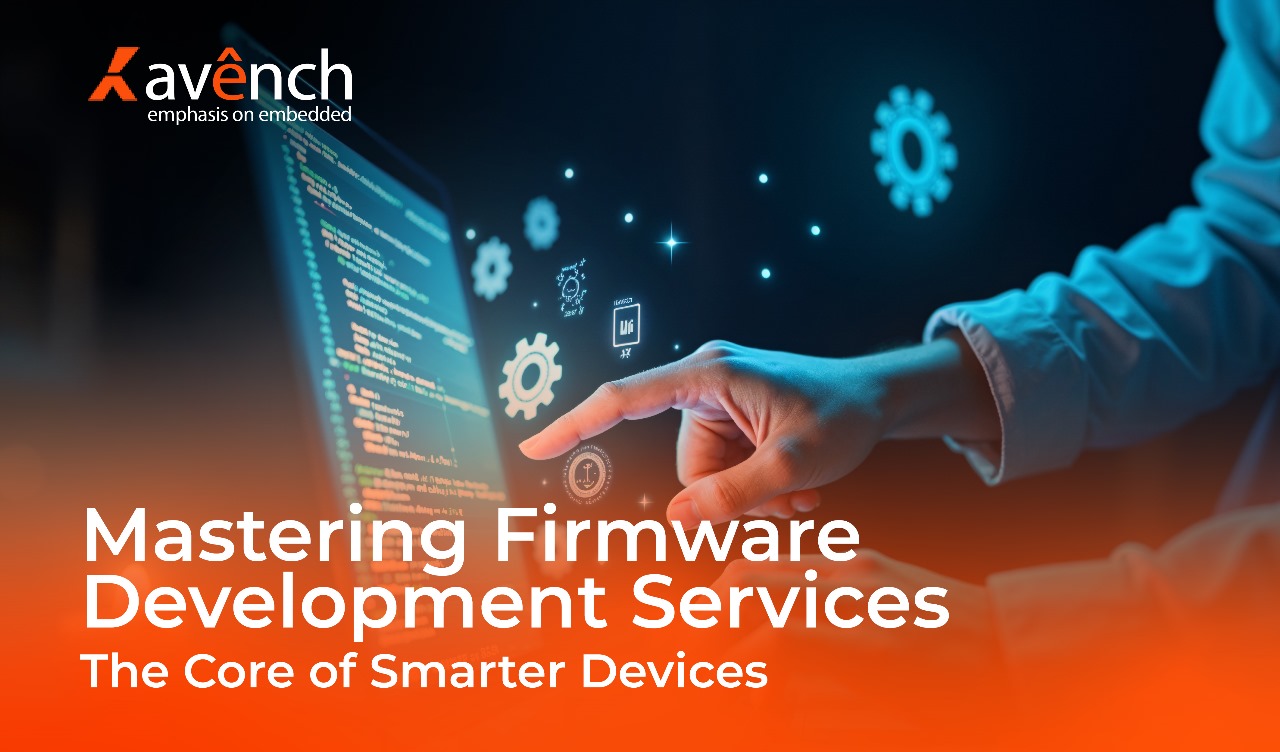This is a backbone of modern embedded systems, firmware has evolved from a simple hardware interface to a sophisticated component essential for advanced device functionality. Firmware is the layer that brings hardware to life, instructing how devices interact with their environment, users, and even other devices. Businesses and engineers alike are unlocking the power of firmware development services, especially custom firmware development services, is key to creating cutting-edge solutions.
This blog delves into the technical aspects of embedded firmware development services and explores how high-quality firmware development services can make sure devices perform reliably, securely, and efficiently in today’s complex technological ecosystem.

What Is Firmware, and Why Is It Crucial?
Firmware is referred to as specialized, low-level software embedded in hardware components like microcontrollers, sensors, or processors. Unlike application software, firmware is hardware-specific and often designed for real-time operations. Its primary goal is to provide control over hardware functionality while ensuring seamless integration with higher-level software.
For experts, firmware goes beyond mere functionality:
- It optimizes hardware performance.
- It ensures real-time responses critical in sectors like automotive safety and industrial automation.
- It supports secure operations in sensitive systems such as IoT and medical devices.

Core Components of Firmware Development Services
To build reliable firmware, developers need expertise in several core technical areas:
1. Microcontroller Architecture and Programming
Firmware developers must deeply understand the microcontroller architecture being used. This includes registers, interrupt handling, and memory organization. Tools like vendor-specific IDEs (e.g., STM32CubeIDE for STMicroelectronics) or open-source platforms (e.g., PlatformIO) play a key role in programming and debugging.
2. Peripheral Configuration and Control
Peripheral management involves setting up timers, GPIOs, communication protocols (SPI, I2C, UART), and ADC/DAC for hardware interaction. Firmware must be optimized for low-latency communication while maintaining power efficiency.
3. Real-Time Operating Systems (RTOS)
RTOS like FreeRTOS or Zephyr is used to manage tasks in real-time systems. It provides scheduling, inter-process communication, and deterministic task execution, ensuring critical tasks meet timing constraints.
4. Communication Protocols
The proliferation of IoT and connected devices demands firmware that supports wireless and wired communication protocols such as:
- MQTT for lightweight IoT communication.
- CAN bus for automotive systems.
- BLE and Zigbee for short-range connectivity.
5. Power Management
Efficient firmware optimizes power consumption using techniques like dynamic clock scaling, deep sleep modes, and peripheral power gating. These features are critical for battery-operated devices.
Challenges Addressed by Custom Firmware Development Services
While off-the-shelf firmware solutions can suffice for generic devices, complex systems often require custom firmware to meet specific requirements. Here’s why custom firmware development services are essential:
1. Hardware-Specific Optimization
Custom firmware is tailored to leverage the full potential of unique hardware designs. For instance, a wearable health monitor may need firmware optimized for continuous data acquisition with minimal power consumption.
2. Integration with Legacy Systems
Many industries, like manufacturing, require firmware that can seamlessly integrate new devices with legacy systems. This involves backward compatibility and support for older communication protocols.
3. Advanced Security Features
Custom firmware can implement secure boot mechanisms, cryptographic algorithms, and firmware integrity checks, addressing the 70% of IoT devices vulnerable to cyberattacks (IoT Analytics).

4. Real-Time Performance
Devices in mission-critical applications—like aerospace or medical systems—must meet stringent real-time performance standards, achievable only through specialized firmware.
Firmware Development Workflow: A Technical Breakdown
Developing robust firmware involves a structured approach to ensure reliability and efficiency:
1. System Requirements and Architecture Design
- Analyze hardware capabilities: Identify available peripherals, clock speeds, and memory constraints.
- Define operational requirements: Specify latency, throughput, and power consumption benchmarks.
- Develop architecture: Design a modular firmware stack, separating hardware abstraction, device drivers, and application layers.
2. Low-Level Driver Development
Low-level drivers directly control hardware components, ensuring efficient interactions with microcontrollers, peripherals, and external interfaces. Driver code must be lightweight and optimized for performance.
3. Middleware and Protocol Integration
Middleware supports essential functionality like communication and data encryption. For example:
- Integrating TCP/IP stacks for networked devices.
- Implementing TLS for secure data transmission.
4. Firmware Testing and Debugging
Testing ensures firmware meets performance and reliability standards. Key techniques include:
- Unit Testing: Verifies individual code modules in isolation.
- Hardware-in-the-Loop (HIL) Testing: Simulates real-world hardware conditions to validate firmware performance.
- Code Profiling: Tools like Keil µVision help identify bottlenecks and optimize execution.
5. Deployment and Maintenance
With the rise of over-the-air (OTA) updates, firmware can be updated remotely. Secure deployment pipelines and rollback mechanisms are critical to avoid bricking devices during updates.
Selecting High-Quality Firmware Development Services
To ensure successful projects, it’s crucial to partner with developers or firms offering high-quality firmware development services. Key traits to look for include:
Expertise in Hardware Platforms: From ARM Cortex-M microcontrollers to custom ASICs, the team should have hands-on experience with various hardware architectures.
Agility in Development: Modular design practices enable quick adaptation to changing requirements or hardware revisions.
Focus on Security: Implementing secure firmware requires knowledge of encryption algorithms, secure boot, and anti-tamper techniques.
Emerging Trends in Firmware Development
The future of firmware is evolving rapidly, driven by innovations and market demands. Key trends include:
1. AI-Powered Optimization
AI tools are beginning to assist firmware developers by identifying inefficiencies in code or predicting hardware faults. For example, machine learning models can optimize power usage in IoT devices based on usage patterns.
2. Firmware for Edge Computing
As edge computing gains traction, firmware must support decentralized data processing and AI inference on lightweight devices. Frameworks like TensorFlow Lite are enabling AI integration in embedded systems.
3. Focus on Open-Source Firmware
Projects like Zephyr and Tock OS are paving the way for collaborative firmware development, offering pre-built components that reduce time-to-market.
4. Energy-Efficient Firmware
With sustainability at the forefront, firmware is being designed to minimize environmental impact. Techniques like energy-aware scheduling and adaptive clock management are gaining importance.
Conclusion
Firmware development is the backbone of modern embedded systems, turning inanimate hardware into dynamic, intelligent devices. With advanced firmware development services, organizations can ensure that their products meet the demands of a competitive, fast-evolving market.
Whether you need embedded firmware development services for industrial IoT devices or custom firmware development services tailored to specialized hardware, quality always comes first. High-quality, robust, secure, and optimized firmware is not just a technical necessity; it is a strategic advantage.
Are you ready to take your next project to the next level with high-quality firmware development services? Partner with experts who understand the intricacies of embedded systems and can deliver solutions that exceed expectations.
Avench is one of the leading , embedded systems development in usa to know more information for any sales queries, wait for no further contact us at +1 (775) 404-5757. You can also email us at sales@avench.com, or fill the query form in a website.

